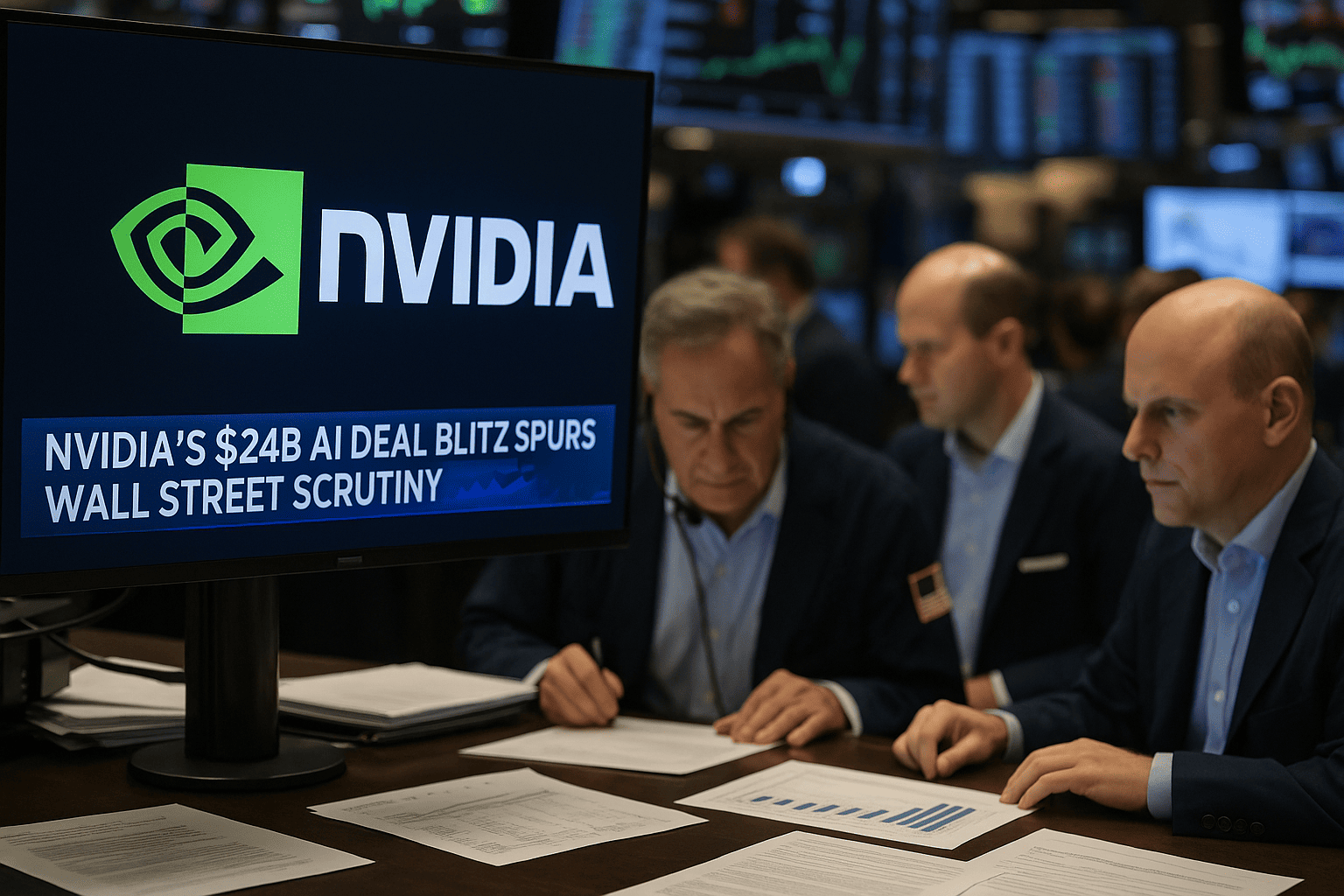Nvidia’s $24B AI Deal Blitz Spurs Wall Street Scrutiny
By Tredu.com • 11/19/2025
Tredu

What is new
Nvidia’s $24B AI deal blitz spurs Wall Street scrutiny after a run of investments and commitments into model labs and “neocloud” providers that are also large GPU customers. Yahoo Finance tallied roughly $23.7 billion in 2025 deployments, a figure that sharpened analyst questions about how much end demand is organic versus supported by vendor cash, equity, or warrants.
What sits inside the $24B figure
Disclosed and reported items span direct stakes in infrastructure providers, multi-year commercial tie-ups that embed financing features, and strategic allocations to AI application companies. Public coverage highlights Nvidia’s exposure to CoreWeave and other GPU cloud operators, plus headline commitments tied to OpenAI’s compute buildout. The mix varies by deal, yet the common thread is that recipients are positioned to purchase large volumes of Nvidia accelerators.
Why investors call parts of this “circular”
The concern is a loop. Nvidia invests in, or extends financing to, companies that then buy Nvidia systems, which flatters backlog and revenue while raising questions about ultimate user demand. Analysts and commentators have compared the pattern to prior cycles of vendor financing in telecom, with the important caveat that AI buyers monetize capacity through cloud rentals and model services rather than regulated carrier tariffs.
Counterarguments from the bull case
Supporters note that supplier prepayments, capacity reservations, and equity linkages are common in capital-intensive buildouts, including semis and energy. They also argue that the addressable market is expanding beyond a single model lab to hyperscalers, enterprises, and governments, which makes circularity a smaller slice of total demand. Recent analysis from market strategists framed AI deal webs as complex but not necessarily bubble-defining so long as profits scale with deployed compute.
The OpenAI, Oracle, and neocloud triangle
Reports through autumn outlined multi-hundred-billion infrastructure plans centered on OpenAI, with compute sourced from Oracle and GPU supply anchored by Nvidia. In parallel, neoclouds such as CoreWeave signed multi-year contracts with model developers and large platforms. The web of obligations, options, and equity rights can blur the clean separation between buyer and seller, which is why investors keep asking for disclosure on who funds what, when, and on what terms.
What the tape is trying to price
Three issues dominate models. First, durability of orders when financing features expire or when customers face slower end-user uptake. Second, the mix between one-off system sales and higher-margin networking and software attach, which drives gross-profit dollars per rack. Third, the extent to which GPU-backed debt at cloud partners tightens or loosens as utilization trends emerge. Each factor influences the gap between booked backlog and realized cash.
Risk lens: accounting, disclosure, and policy
Regulators could examine related-party exposure, disclosure around equity or warrant sweeteners, and recognition of revenue tied to financed buyers. None of this implies wrongdoing; it does suggest higher scrutiny when a supplier both funds and sells into the same ecosystem. A stricter stance would add friction to deal structures that rely on embedded options or asset-backed facilities secured by GPUs.
How management can defuse “murky” optics
Clarity helps. Break out investment totals by category. Quantify shipments to financed counterparties versus independent buyers. Disclose terms for any equity or warrant consideration linked to purchase commitments. Provide cohort utilization metrics that connect deployed compute to recurring revenue at customers. These steps would let investors separate healthy ecosystem building from artificial demand pull-forward.
Fundamental backdrop still matters most
Even with circularity questions, the core drivers remain hyperscaler capex, enterprise adoption, and software monetization. New multi-year cloud contracts for AI capacity, including a $14.2B CoreWeave–Meta agreement through 2031, suggest broadening demand for training and inference. If those tenants fill racks and renew, financed deals can look like reasonable catalysts rather than props. If not, leverage and pricing power could compress faster than models assume.
Market reaction so far
Shares have wobbled around the headlines rather than broken trend, reflecting a tug-of-war between huge profit growth and higher risk flags. On days when deal scrutiny rises, investors rotate toward names with cleaner end-market visibility or toward diversified platform exposure. When bookings or guidance confirm breadth, the stock reclaims momentum. The debate is about quality of revenue, not the reality that AI compute remains scarce in several markets.
What to watch next
- Updated investment totals and counterparties in the next shareholder letter. 2) Any shift in financing mix at neoclouds, including GPU-backed debt terms. 3) Disclosure from OpenAI, Oracle, and large platforms that ties capacity adds to contracted economics. 4) Commentary from auditors or regulators on recognition and related-party risk. 5) Evidence that software and networking attach lift margin dollars even if system ASPs normalize.
Bottom line
Nvidia’s $24B AI deal blitz spurs Wall Street scrutiny, for a simple reason: supplier capital is flowing into customers that buy the supplier’s chips. If utilization stays high and renewals stack up, the web of investments will read as ecosystem building. If not, investors will demand cleaner separation between funding and sales, and the market will discount financed demand more aggressively.

How to Trade Like a Pro
Unlock the secrets of professional trading with our comprehensive guide. Discover proven strategies, risk management techniques, and market insights that will help you navigate the financial markets confidently and successfully.


